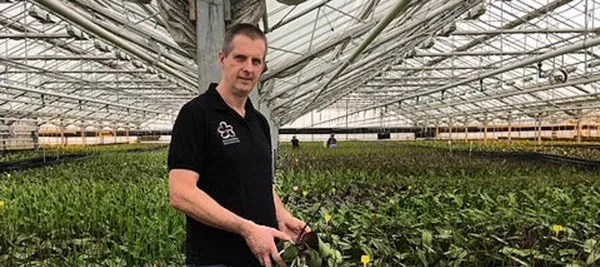Reflecting too much or too little light impacts on production in any crop. With ReduSol, it is easy to adjust the percentage of light and heat that is reflected. But heat stress is often a bigger problem than too much light. In that case, ReduHeat is the answer.
In any crop, more light means more production. But there is a limit, and that limit differs depending on the crop and often even the variety. So, the basic principle with coatings is to keep as much light coming in as possible while protecting the crop against potential damage.
Both light stress and heat stress can damage the crop. In recent years, horticultural research has regularly shown that heat stress plays a much bigger role in many crops than light stress. If a grower can manage the climatic conditions properly, they can let in more light, which will result in higher production, better quality, and a faster growth rate. But it is also essential to keep the relative humidity high enough and not to let the plant temperature rise too high.
Reflecting both light and heat
ReduSol is the coating of choice for growers who want to reflect both light and heat. Even a thin coating will soon reflect 20% of the solar radiation. The maximum you can achieve is 40%. That’s the net reflection of the coating. But the greenhouse roof also reflects light, so with the maximum coating thickness, you can reduce the amount of solar radiation reaching the crop by as much as 75-80% compared with the level measured outside the greenhouse.
This can be a good solution in regions with very high light levels. In these conditions, the foliage constantly functions at a sub-optimal level in order to protect itself against too much light. What’s more, high light levels produce free radicals – substances that react aggressively with all parts of the plant cell, causing damage and potentially even cell death. In temperate zones, growers tend to opt for a thinner coating combined with screens that they can close at peak light levels.
In many cases, the amount of light a crop can cope with is known. This data is matched with the development of light intensity over the course of the year. Then a light plan can be drawn up for the whole year, in which the coating, the adjustable screen strips, and the climate control system interact to achieve the optimum result.
Heat radiation
Sunlight consists of three components: UV, PAR, and infrared light. You generally don’t want to screen out too much PAR light because the plant uses it for photosynthesis and, consequently, for production. Infrared light, also known as heat radiation, heats up the crop. Up to a point, that’s a good thing, given that all plant processes speed up as the temperature rises. But there is a limit: the combination of high light intensity, a high plant temperature, and low humidity will first bring photosynthesis to a halt and will then cause damage to the plant.
The plant does nothing at all with the bulk of the infrared light, so it is quite safe to filter it out. That is what ReduHeat does. In the PAR range, ReduHeat eliminates between 10 and 16% of the light, depending on the thickness of the coating. In the infrared range, it gets rid of as much as 30%. So, it keeps a significant proportion of the heat radiation out of the greenhouse while at the same time greatly reducing the risk of heat stress.
Phalaenopsis
Theo Verbeek, cultivation manager at Dutch orchid growers Ammerlaan Orchideeën, reaps the benefits of both coatings. The company has two sites in De Lier and Schipluiden. “Vegetative growth takes place at De Lier,” Verbeek explains. “Then we move the plants, benches and all, to Schipluiden, where we grow them on for a while. After that, they go into the cooling department to encourage flowering. After six weeks, they are moved to the generative area. That section is above the processing area; the plants are just two meters below the glass.”
Phalaenopsis is a shade-loving plant that is very sensitive to too much light. It is what is known as a CAM plant, which photosynthesizes in a different way. During the night, the orchid binds CO2 in the form of malate, but its capacity for storing malate is limited. During the day, the malate is converted into sugars by photosynthesis, for which light is needed. At some point, the stored malate is used up, and the plant can’t make use of any extra light. That is why growers tend to work strictly with a maximum permissible light sum per day.
Verbeek again: “At the generative stage, we apply a light sum of 7 mol/m2. We also limit the light level to 250 W/m2 as otherwise, the leaf temperature rises too high. We aim for a leaf temperature of 23-24°C.” If the solar radiation rises above 250 W/m2, the screens close.
All sections of the greenhouse are coated with ReduSol from the beginning of March onwards when the natural light level starts to become too much for the plant. If the light level still gets too high, they use the screens as well.

“But that wasn’t enough in the generative area, where the plants are just below the glass,” Verbeek adds. “Even in early February, you can have days with alternating sunshine and clouds, and that makes for a very unsettled climate. And you can’t use ReduSol yet as you want to achieve your light sum. We found that ReduHeat was the answer; we applied it as early as week 7.”
Combining ReduHeat and ReduSol
Verbeek has four years of experience with this approach under his belt. Before that, he would have occasional problems with underperformers, with flower spikes not developing properly because of the rising plant temperature. “We would get lots of single spikes instead of double ones, which meant that the plant was worth much less. Without ReduHeat, we had to close the screens at as little as 150 W/m2, which inevitably costs you light. Since we started using ReduHeat, the climate has become more settled without impacting our light sum. And that results in better quality plants.”
He applies a coating of ReduSol on top of the ReduHeat around week 14-15. Once the ReduSol is applied, the coating has the combined properties of both products. The two coatings were removed in early September. “This system works very well for us,” the grower concludes.
For more information: ReduSystems
ReduSystems
Tel.: +31(0)13 507 53 99
sales@redusystems.com
www.redusystems.com
